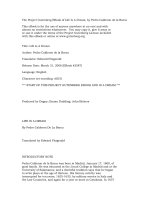Covid-19: A silent killer
Bạn đang xem bản rút gọn của tài liệu. Xem và tải ngay bản đầy đủ của tài liệu tại đây (391.82 KB, 10 trang )
Int.J.Curr.Microbiol.App.Sci (2020) 9(5): 2710-2719
International Journal of Current Microbiology and Applied Sciences
ISSN: 2319-7706 Volume 9 Number 5 (2020)
Journal homepage:
Review Article
/>
Covid-19: A Silent Killer
Nikita Birhman1*, Mithilesh Kumar Singh2, Shipra Tomar3 and Shrutika Pundir4
1
Medical Microbiology, School of Medical Sciences & Research,
Sharda University, Greater Noida, Uttar Pradesh, India-201306
2
Medical Biochemistry, Noida International Institute of Medical Sciences,
Greater Noida, Uttar Pradesh, India-203201
*Corresponding author
ABSTRACT
Keywords
COVID-19, Corona
Virus, RNA virus,
Public health,
Pandemic
Article Info
Accepted:
23 April 2020
Available Online:
10 May 2020
The symptom such as pneumonia, fever, breathing difficulty, and lung infection are
commonly shown by coronavirus belongs to a family of viruses. The World Health
Organization (WHO) on 11th February 2020 announced this virus official name as
COVID-19 which full form is Corona Virus Infectious Disease and 19 indicates that it
originated in 2019.Despite the efforts of the entire world to grasp COVID-19, many issues
remain unclear. The Director-General of WHO declared the outbreak of COVID-19 as a
Public Health Emergency of International Concern on 30 January 2020. Rapid diagnostics
play a very important role in disease and outbreak management. The fast and accurate
diagnosis of a specific infection enables prompt and accurate public health surveillance,
prevention, and control measures. In conclusion, it remains a challenging task to fight the
2019-nCoV of unknown origin and biological features and to manage an outbreak of
COVID-19. Rapid diagnostics, vaccines, and therapeutics are key pharmaceutical
interventions to limit the transmission of respiratory infectious diseases.
Introduction
The symptoms such as pneumonia, fever,
breathing difficulty, and lung infection are
commonly shown by coronavirus belong to a
family of viruses. The World Health
Organization (WHO) on 11th February 2020
announced this virus official name as
COVID-19 which full form is Corona Virus
Infectious Disease and 19 indicates that it
originated in 2019. The COVID-19 outbreak
takes place first in Wuhan city of China on 29
December 2019 as the cause of an outbreak of
respiratory illness.(1)
Coronaviruses belong to the largest group of
viruses the Nidovirales order, which includes
Coronaviridae, Arteriviridae, Mesoniviridae,
and Roniviridae families. The viruses belong
to Nidovirales order are enveloped, nonsegmented positive-sense RNA viruses.
Coronavirus is spherical with diameters of
2710
Int.J.Curr.Microbiol.App.Sci (2020) 9(5): 2710-2719
approximately 125nm. The prominent feature
of Coronaviruses is the spike projections with
a crown-like structure on that which is the
defining feature and that too gives its name as
Corona Virus. Within the envelope of the
virion is the nucleocapsid which is
uncommon among positive-sense RNA
viruses, but far more common for negativesense RNA viruses. (2)
COVID -19 is a public health emergency of
international concern but to date, no known
specific, effective, proven, pharmacological
treatment available. Some studies suggested
that chloroquine, an immune-modulating drug
traditionally used to treat malaria, is effective
in reducing viral replication in other
infections, including the Server Acute
Respiratory Syndrome Corona Virus (SARSC0V) and Middle East Respiratory Syndrome
Corona Virus (MERS-CoV).(3)
Epidemiology
In Wuhan city, many cases of pneumonia
were reported in December 2019.(4) The first
case of the COVID-19 epidemic was
discovered on 12 Dec 2019(5). The WHO
Director-General Dr. Tedros Adhanom
Ghebreyesus announced on February 11,
2020, that the disease is caused by new CoV.
Globally, 5th May 2020 there have been
3,489,053 confirmed cases of COVID-19,
including 241,559 deaths, reported to WHO
whereas according to the Ministry of Health
and Family Welfare of India there have been
31967 active cases, 13160 cured /discharged,
1583 deaths and 1 migrated.
Pathogenesis
The genome structure of Coronaviruses is
best known among all RNA viruses. Out of
total RNA, two-thirds of RNA they have
encodes viral polymerase (RdRp), RNA
synthesis
materials,
and
two
large
nonstructural polyproteins which not involved
in host response modulation (ORF1a-ORF1b)
and the other one-third of the genome encodes
four structural proteins spike, envelope,
membrane, nucleocapsid, and the other helper
proteins.(6) In the virus infection, the first step
is with Spike Protein which interacts with
sensitive human cells. After entering the cell
genome it encoding occurs which encodes
useful accessory proteins and that protein
facilitates the expression of genes and that
leads to adaptation of CoVs to their human
host.(7) The changes in the genomes resulting
from recombination, gene exchange, gene
insertion, or deletion are frequent among
CoVs, and this will take place in future
outbreaks.(8)
Symptoms of Covid -19
According to the World Health Organization
(WHO) and the Centers for Disease Control
and Prevention (CDC), the common
symptoms are:
Dry cough
Fever
Sore throat
Shortness of breath
Headache
Body aches
Exhaustion
Diagnostics
Among the many diagnostic platforms
available Real-Time Polymerase Chain
Reaction (RT-PCR) remains the primary
means for diagnosing the health emergence of
2019-nCoV.(9) The period and type of
specimen collected play an important role in
the diagnosis of 2019-nCoV. It was found that
the respiratory specimens were positive for
the virus while serum was negative in the
early period and the serum as a specimen
needs to be studied further. It has also
2711
Int.J.Curr.Microbiol.App.Sci (2020) 9(5): 2710-2719
suggested that in the early days of illness,
patients have high levels of the virus despite
the mild symptoms.
The most commonly used diagnosing method
was RT-PCR in MERS-CoV. RT-LAMP has
similar sensitivity as real-time RT-PCR. It is
highly specific and used to detect MERSCoV. It is rapid, simple, and convenient
comparable to the usual diagnostic tests.
Potential vaccines
A wide range of technology (such as
messenger RNA, DNA-based, nanoparticle,
synthetic, and modified virus-like particle)
about 15 potential vaccine candidates in the
pipeline globally with the emergence of 2019nCoV, was applied. However, the kit
developed by the Beijing Genomics Institute
(BGI) has passed an emergency approval
procedure of the National Medical Products
Administration and used in clinical and
surveillance centers of China.(19) All 15
potential vaccine candidates were reported to
be safe, well-tolerated, and able to trigger the
relevant and appropriate immune responses
for SARS and MERS.(20)
Discussion
Despite the efforts of the entire world to grasp
COVID-19, many issues remain unclear.(34)
The Director-General of WHO declared the
outbreak of COVID-19 as a Public Health
Emergency of International Concern on 30
January 2020. The disease spectrum ranges
from mild to life-threatening.(35)
The clinical manifestation of COVID-19
ranges from asymptomatic carrier state to
severe pneumonia as early reports mostly
showed the findings of SARS-CoV-2
pneumonia within which the ratio of male
patients was much larger than that of female
patients.(35) Besides, as most of the studies are
being conducted everywhere the globe it's
important to clarify the epidemiologic
characteristics of COVID-19. Respiratory
droplets and contacts are considered because
of the main route of transmission.
Epidemiological changes in COVID-19
infection should be monitored taking into
consideration potential routes of transmission
and subclinical infections, additionally to the
variation, evolution, and virus spread among
humans and possible intermediate animals
and reservoirs. To identify the danger and
prognostic factors of patients infected with
SARS-CoV-2. As there's a priority for the
spread of viruses thanks to cough induced by
performing throat swabs, nasal swabs is also a
comparatively safe and sensitive alternative to
gather a respiratory specimen of patients with
COVID-19. Rapid diagnostics play a very
important role in disease and outbreak
management. The fast and accurate diagnosis
of a specific infection enables prompt and
accurate
public
health
surveillance,
prevention, and control measures.(36)
Laboratory diagnosis could also be performed
by (a) detecting the genetic material of the
virus, (b) detecting the antibodies that
neutralize the viral particles of interest, (c)
detecting the viral epitopes of interest with
antibodies (serological testing), or (d) culture
and isolation of viable virus particles.(37)
Serological testing like ELISA, IIFT, and
neutralization tests are eff ective in
determining the extent of the infection,
including estimating asymptomatic and attack
rates. Compared to the detection of the viral
genome
through
molecular
methods,
serological testing detects antibodies and
antigens. Vaccines can prevent and protect
against infection and disease occurrence when
exposed to the specific pathogen of interest,
especially in vulnerable populations who are
at risk of severe outcomes.
2712
Int.J.Curr.Microbiol.App.Sci (2020) 9(5): 2710-2719
Table.1 Potential commercial rapid diagnostic kits for 2019-nCoV
S.No
1.
Type
RT-PCR
2.
RT-PCR
3.
RT-PCR
Commercial Kit RT- Stated to be Claims
with 12,13
PCR kit
high but with lower
false
no
positive1
accompanying
statistics.
4.
RT-PCR
Commercial Kit RT- Not stated
PCR kit
5.
RT-PCR
6.
7.
Test
RT-PCR Kit Master
Mix and q16 reaction
tubes included (for
gene sig® q16); PCR
Master Mix Kit (for
other instruments)
RT-PCR test kit
Fluorescent RT-PCR
kit In vitro RT-PCR
combining
fluorescent probing 1
Combined
2019-nCoV PMseq
RT-PCR and Kit A metagenomics
metagenomic sequencing kit based
s detection
on
combinatorial
Probe
Anchor
Synthesis. Able to
detect both known
and
novel
microorganisms,
Enabling monitoring
of evolution during
transmission
Microfluidic enVision (enzymeassisted
nano
complexes for visual
identification
of
nucleic acids) Labon-Chip
platform
integrating PCR and
microarray
Sensitivity
Sensitive to <
100 copies of
target
Broad
dynamic
detection range
(>6 logs)
Not stated
Specificity
Reference
Stated to be 10
high but with
no
accompanying
statistics
Not stated
11
Not stated
14
Not stated
Not stated
15
Not stated
Not stated
16
Stated to be
high but with
no
accompanying
statistics.
Stated to be 17,18
high but with
no
accompanying
statistics.
2713
Int.J.Curr.Microbiol.App.Sci (2020) 9(5): 2710-2719
Table.2 Potential therapeutics
Treatment
Lopinavir-ritonavir
Teicoplanin (Targocid)
Remdesivir
Monoclonal antibodies
Monoclonal antibodies
Ritonavir + ASC09 combo
Galidesivir
Stage
Approved
Used in clinical settings.
The Jin Yintan Hospital in Wuhan,
China, launched a randomized, openlabel, blank-controlled trial for the
efficacy and safety of lopinavir-ritonavir
and
interferon-alpha
2b
in
the
hospitalization of 80 patients with novel
coronavirus infection.
Lopinavir-ritonavir
tablets
(each
containing 200 mg of lopinavir and 50
mg of ritonavir), twice a day, 2 tablets at
a time; interferon-α2b.
Assessment of effectiveness of treatment
based on clinical improvement time of 28
days after randomization.[21]
Approved.
Used in a clinical setting
Gilead is in active discussions with
researchers and clinicians in the United
States and China regarding the ongoing
Wuhan coronavirus outbreak and the
potential use of remdesivir as an
investigational treatment.[22]
Vir is working to rapidly determine
whether its previously identified anticoronavirus
monoclonal
antibodies
(mAbs) bind and neutralize 2019nCoV.[23]
Regeneron
Pharmaceuticals
has
developed monoclonal antibodies to treat
MERS that are now being tested in early
human studies. A company spokesperson
said that researchers have begun to
identify similar antibodies that might
work against 2019-nCoV. With Ebola, it
took Regeneron six months to develop
candidate treatments and test them in
animal models.[24]
Applied to include in a national
emergency channel on 25 January 2020.
Not yet approved by regulators.[25]
Biocryst is evaluating Galidesivir to
2714
Int.J.Curr.Microbiol.App.Sci (2020) 9(5): 2710-2719
Molecules that inhibit
coronavirus enzymes
2
“Xue bi jing” (TCM) ChiCTR2000029381
Adjunctive steroids have a
trial-ChiCTR2000029386
Umefinovir
(arbidol)NCT04260594
Darunavir-NCT04252274
Lopinavir Plus Ritonavir and
Arbidol
Abidol
hydrochloride,
Oseltamivir,
Lopinavir/ritonavir
Hydroxychloroquine
determine if it could potentially target the
coronavirus. Galidesivir is currently in
phase 1 clinical study.[26]
Molecules developed by the university
scientists inhibit two coronavirus
enzymes and prevent its replication. The
discovered drug targets are said to be
more than 95% similar to enzyme targets
found on the SARS virus. Researchers
note that identified drugs may not be
available to address the ongoing outbreak
but they hope to make it accessible for
future outbreaks.[27]
Approved. The recruitment of subjects
has not started.[28]
Approved. The recruitment of subjects
has not started.[29]
Antiviral
treatment
for
influenza
infection. The preliminary test in the in
vitro cell showed an eff ective inhibition
of coronavirus and a significant inhibition
of the cytopathic eff ect.[30]
Antiviral treatment for HIV. The study
showed that it can significantly inhibit the
replication of the new coronavirus.[30]
Recruitment in the process; Interventional
subjects will receive either standard
treatment plus a regimen of lopinavir
(200 mg) and ritonavir (50 mg) (oral,
q12h, every time 2 tablets of each, taking
for 7–14 days) or Standard treatment plus
a regimen of arbidol (100 mg) (oral, tid,
200 mg each time, taking for 7–14
days).[31]
Recruitment of subjects has not started;
Interventional subjects will receive either
Abidol hydrochloride 0.2 g once, 3 times
a day, 2 weeks or Oseltamivir 75 mg
once, twice a day, 2 weeks or
Lopinavir/ritonavir 500 mg once, twice a
day, 2 weeks.[32]
Recruitment in the process; Interventional
subjects will receive hydroxychloroquine
400 mg per day for 5 days, also take
conventional treatments.[33]
2715
Int.J.Curr.Microbiol.App.Sci (2020) 9(5): 2710-2719
Vaccines against the 2019-nCoV are currently
in development and none are interesting (at
the time of writing). On 23 January 2020, the
Coalition
for
Epidemic
Preparedness
Innovations (CEPI) announced that they'll
fund vaccine development programs with
Inovio, The University of Queensland, and
Moderna, Inc respectively, to check the
experimental vaccines clinically in 16 weeks
(By June 2020).
The vaccine candidates are going to be
developed by the DNA, recombinant, and
mRNA vaccine platforms from these
organizations.(37) Lopinavir/ritonavir (Kaletra)
was the earliest antiviral agent combination
introduced for the treatment of SARS-CoV.
Combined usage with ribavirin was also
related to a lower incidence of acute
respiratory distress syndrome, nosocomial
infection, and death, amongst other favorable
outcomes.
A known antimalarial agent, chloroquine,
elicit antiviral effects against multiple viruses
including HIV type 1, viral hepatitis, and
HCoV-229E. Chloroquine is additionally
immunomodulatory, capable of suppressing
the assembly and release of things that
mediate the inflammatory complications of
viral diseases (tumor necrosis factor and
interleukin 6).(38) Thanks to the rapidly
evolving situation of the 2019-nCoV, there'll
be potential limitations to the systematic
review.
Extensive measures should be taken to scale
back person-to-person transmission of
COVID-19 to regulate this outbreak. To scale
back transmission special efforts and a focus
should be applied to the population including
children and elderly people.(13) The most
death causes of COVID-19 outbreak occurred
mostly in elderly people thanks to their
system which allows the faster progression of
the infection. The overall public services and
facilities should provide de-contaminating
reagents for cleaning hands on a routine basis.
Physical contact with wet and contaminated
objects should be considered in handling the
virus, especially agents like fecal and urine
samples that will potentially function an
alternate route of transmission. Recognition,
quarantine, and treatment of the confirmed
patients are critically important.
Over the past few years, the arena of corona
virology has advanced significantly. The
SARS epidemic and COVID-19 pandemic are
a reminder that animal coronaviruses are
potential threats to the human population. The
outbreak of COVID-19 has become a clinical
threat to the ultimate population and
healthcare workers worldwide and up to now
no promising clinical treatments or prevention
strategies are developed against human
coronaviruses.(34)
In
kipping
with
certain
studies,
Corticosteroids didn't affect mortality, but
they delayed the viral clearance.(40) There's
ongoing research for developing efficient
therapeutic strategies to deal with the
COVID-19.
Various broad-spectrum antivirals used
against influenza, SARS, and MERS
coronaviruses are evaluated either alone or in
combinations to treat COVID-19 patients.
Remdesivir, Lopinavir, and Ritonavir
significantly blocked the COVID-19 infection
in infected patients.
Also Chloroquine, medicine for the treatment
of malaria showed remarkable inhibition
within the spread of SARS-CoV and COVID19. The foremost effective because of cope up
with this case is to chop back person-toperson transmission of COVID-19.(39)
In conclusion, it remains a challenging task to
fight the 2019-nCoV of unknown origin and
2716
Int.J.Curr.Microbiol.App.Sci (2020) 9(5): 2710-2719
biological features and to manage an outbreak
of COVID-19. Rapid diagnostics, vaccines,
and therapeutics are key pharmaceutical
interventions to limit the transmission of
respiratory infectious diseases.
10.
References
1.
2.
3.
4.
5.
6.
7.
8.
9.
Arksey and O’ Malley. Infectious Diseases
of Poverty, 9, Jan 2020.
Fehr R.A and Perlman S. Coronaviruses:
An Overview of Their Replication and
Pathogenesis, 1282, New York 2015.
Cortegiani A, Ingoglia G, Ippolito M,
Giarratano A, Einav S. A systemic review
on the efficacy and safety of chloroquine
for the treatment of COVID-19, March
2020.
Imperial College of London. Report 2:
estimating the potential total number of
novel coronavirus cases in Wuhan City,
China.
Jan
2020.
/>World Health Organization, 2019- nCoV
Situation Report-22 on 12 February 2020.
/>onaviruse/situation-reports/
Luk HK, Li X, Fung J, Lau SK, Woo PC.
Molecular epidemiology, evolution and
phylogeny of SARS coronavirus. Infection,
Genetics and Evolution 2019; 71: 21–30.
Coronavirinae in ViralZone. Available
online: https://viralzone. expasy.org/785
(accessed on 05 February 2019).
Subissi L, Posthuma CC, Collet A,
Zevenhoven-Dobbe JC, Gorbalenya AE,
Decroly E, et al., One severe acute
respiratory syndrome coronavirus protein
complex integrates processive RNA
polymerase and exonuclease activities.
Proc Natl Acad Sci USA 2014; 111:
E3900–E3909.
Charité Virology. Diagnostic detection of
Wuhan coronavirus 2019 (17 January
2019).
Available
online:
/>
11.
12.
13.
14.
15.
16.
17.
2717
source/coronaviruse/protocol-v21.pdf?sfvrsn=a9ef618c_2 (accessed on 28
January 2020).
Genesig. Novel coronavirus strain 2019ncov.
Available
online:
/>ovel-coronavirus-strain-2019-ncov.
(accessed on 30 January 2020).
Today.
Brief-jiangsu
bioperfectus
technologies develops test kit for new china
coronavirus.
Available
online:
/>(accessed on 30 January 2020).
Co-Diagnostics Inc. Co-diagnostics inc
designs test for new coronavirus using
coprimer platform. Available online:
(accessed on 30 January 2020).
Genetic Engineering & Biotechnology
News. Coronavirus detection test in the
works for wuhan. Available online:
/>virus-detection-test-in-the-works-forwuhan/ (accessed on 30 January 2020).
Altona Diagnostics. Altonadiagnostics is
developing a rt-pcr it for detection of novel
coronavirus(2019-ncov). Available online:
/>html
(accessed on 28 January 2020).
BGI. Bgi develops real-time fluorescent rtpcr kit for detecting the 2019 novel
coronavirus.
Available
online:
/>/bgi-develops-real-time-dna-based-kit-fordetectingthe-2019-novel-coronavirus/
(accessed on 30 January 2020).
MGI. Bgi responds to novel coronavirus
with real-time detection kits, deploys
emergency team to wuhan. Available
online:
/>(accessed on 30 January 2020).
Ng, R.J. Singapore biotech firm veredus
expects to have wuhan virus test by feb 1.
Available
online:
Int.J.Curr.Microbiol.App.Sci (2020) 9(5): 2710-2719
18.
19.
20.
21.
22.
23.
/>ies-markets/singapore-biotech-firmveredus-expectsto-have-wuhan-virus-testby-feb-1 (accessed on 30 January 2020).
Veredus Laboratories Pte Ltd. Veredus
laboratories announces the development of
a lab-on-chip for the detection of
3coronaviruses: Mers-cov, sars-cov and
2019-ncov.
Available
online:
/>wordpress/wpcontent/uploads/2020/01/VereCoV-PressRelease-Final.pdf (accessed on 30 January
2020).
BGI. Bgi develops real-time fluorescent rtpcr kit for detecting the 2019 novel
coronavirus.
Available
online:
/>/bgi-develops-real-time-dna-based-kit-fordetectingthe-2019-novel-coronavirus/
(accessed on 30 January 2020).
Nct. Evaluate the safety, tolerability and
immunogenicity study of gls-5300 in
healthy volunteers. 2019. Available online:
/>T03721718?term=vaccine&cond=Mers+C
oV& draw=2&rank=7 (accessed on 28
January 2020).
Chinese Clinical Trial Registry. A
randomized, open-label, blank-controlled
trial for the efficacy and safety of lopinavirritonavir and interferon-alpha 2b in
hospitalization
patients
with
novel
coronavirus infection. Available online:
/>proj=48684 (accessed on 29 January 2020).
Taylor, N.P. Gilead mulls repositioning
failed ebola drug in china virus. Available
online:
https:
//www.fiercebiotech.com/biotech/gileadmulls-repositioning-failed-ebola-drugchina-virus (accessed on 29 January 2020).
VIR. Vir biotechnology applying multiple
platforms to address public health risk from
wuhan coronavirus. Available online:
(accessed on 28 January
2020).
24. Science Mag. Can an anti-hiv combination
or other existing drugs outwit the new
coronavirus?
Available
online:
/>/can-anti-hiv-combination-or-otherexistingdrugs-outwit-new-coronavirus
(accessed on 29 January 2020).
25. Today. Brief-ascletis pharma clarifies
media reports on coronavirus treatment.
Available
online:
/>ypage (accessed on 29 January 2020).
26. Speights, K. 5 biotech stocks to watch with
the coronavirus scare. Available online:
/>investing/2020/01/26/what-to-expect-inpfizers-q3-earnings-update.aspx (accessed
on 29 January 2020).
27. Pharmaceutical Tech. Coronavirus: Gilead,
purdue university explore potential
treatments.
Available
online:
(Accessed on 29 January
2020).
28. Chinese Clinical Trial Registry. A
prospective comparative study for xue-bijing injection in the treatment of
pneumonia cause by novel coronavirus
infection.
Available
online:
/>aspx?id=21735 (accessed on 7 February
2020).
29. Chinese Clinical Trial Registry. Adjunctive
corticosteroid therapy for patients with
severe
2019-ncov
pneumonia:
A
randomized controlled trial. Available
online:
/>proj=48777 (accessed on 7 February 2020).
30. Mak, E. Coronavirus outbreak pushes
Chinese biotech stocks higher despite
market downturn. Available online:
(accessed on 7 February 2020).
2718
Int.J.Curr.Microbiol.App.Sci (2020) 9(5): 2710-2719
31. ClinicalTrials.gov. The efficacy of lopinavir
plus ritonavir and arbidol against novel
coronavirus infection. Available online:
/>52885 (accessed on 10 February 2020)
32. ClinicalTrials.gov.
A
prospective,
randomized controlled clinical study of
antiviral therapy in the 2019-ncov
pneumonia.
Available
online:
/>55017 (accessed on 10 February 2020).
33. ClinicalTrials.gov. Efficacy and safety of
hydroxychloroquine for treatment of
pneumonia caused by 2019-ncov (hcncov).
Available
online:
/>61517 (accessed on 10 February 2020).
34. Lai C, Shih T, Ko W, Severe acute
respiratory syndrome coronavirus 2
(SARS-CoV-2) and coronavirus disease2019 (COVID-19): The epidemic and the
challenges,
2020
/>05924
35. Lai C , Liu Yen H, Wang C, et al.,
Asymptomatic
carrier
state,
acute
respiratory disease, and pneumonia due to
severe acute respiratory syndrome corona
virus 2 (SARS-CoV-2): Facts and myths.
2020. />
.012
36. Corman, V.M., Landt, O., Kaiser, M.,
Molenkamp, R., Meijer, A., Chu, D.K.,
Bleicker, T., Brünink, S., Schneider, J.,
Schmidt, M.L., et al., Detection of 2019
novel coronavirus (2019-ncov) by real-time
rt-pcr. Eurosurveillance 2020, 25, 2000045.
CEPI. Cepitofund three programmes to
develop vaccines against the novel
coronavirus, ncov-2019. Available online:
/>(accessed on 29 January 2020).
37. Keyaerts,E.,Vijgen,L.,Maes,P.,Neyts,J.,Ran
st,M.V.In vitro inhibition of severe acute
respiratory syndrome coronavirus by
chloroquine. Biochem. Biophys. Res.
Commun. 2004, 323, 264–268. [CrossRef]
38. Rothan H, Byrareddy S, The epidemiology
and pathogenesis of coronavirus disease
(COVID-19)
outbreak,
2020
/>39. Chaolin H, Yeming W, Xingwang L, et
al., Clinical features of patients infected
with 2019 novel coronavirus in Wuhan,
China.
Lancet
2020;
395:
497–
506. />
How to cite this article:
Nikita Birhman, Mithilesh Kumar Singh, Shipra Tomar and Shrutika Pundir. 2020. Covid-19:
A Silent Killer. Int.J.Curr.Microbiol.App.Sci. 9(05): 2710-2719.
doi: />
2719









